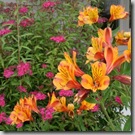
I admit it. I’m in zonal denial. I love the huge tender leaves of bananas, the glorious hanging trumpets of Brugmansia, and anything so wild and lush that it makes me feel like I’m on vacation to the kind of rainforest-y tropics that have monkeys and great winding green snakes and crazy bugs that remind you of your oddly charming uncle, the one with the giant glasses and earnest surprised eyebrows.
Unfortunately so many of my favorites are juuust out of reach for my climate. I can grow a lot of these lovelies, but they usually spend half the year either melted and disheveled from the frost, or recovering from such. My idea of the tropics doesn’t include anything that turns to blackened mush at certain times of the year. So anything I can get my hands on that’s both hardy in my zone 9 climate and looks drippingly lush? Surefire winners for me.
If you’re the same, I’m sure you know about Fuchsias and Cannas by now, but I wanted to share a few lesser-known favorites you might not be growing yet:
Spanish Shawl (Heterocentron elegans, USDA Zones 9-11)
This plant looks rather unassuming when not in bloom, like a slightly larger-leaved version of Baby’s Tears. But put it in the ground and it is OFF! Everywhere I’ve planted these, I come back the next year to discover they’ve formed a clean-looking mat of fresh green leaves with surprisingly large fuchsia flowers ALL OVER. They have little hairy red bracts that hold the flowers, and after each bloom falls off, you’re left with these adorable little red bits highlighting the plant.You don’t think fuchsia and red go together? Well, they do here!
Spanish Shawl will spread out indefinitely, but I’d hate to call them invasive because they seem to stop just short of other plants, so they don’t choke anyone else out – they just travel where there’s nothing and fill in the spaces. I also love the way they trail gently up walls and fences a little ways. They’re great for part or full shade. The best part? After the first year or two you have a strong enough clump that it’s easy to give some to all the friends and neighbors who exclaim jealously over it.
The Third Harmonic Peruvian Lily (Alstroemeria ‘The Third Harmonic’, USDA Zones 7-10)
If you got last month’s Fine Gardening magazine, you’ve heard me exclaim over this unapologetically cheery plant. It does brilliantly in sun or part shade, and it has orangey-gold blooms that make a long-lasting show in a vase with some Dahlias and Verbena bonariensis (it’s planted with a Spirea ‘Neon Flash’ above).
There’s an interesting trick to pruning them – instead of cutting them back at the base when a stem has died or when you want to cut some flowers for a vase – you instead grasp each stalk at the bottom and pull. The stalk makes a satisfying “pop” as it comes out, and this technique effectively divides the plant as you go, keeping it healthy.
Red Lobster Claw (Clianthus puniceus, USDA Zones 8-11)
Greg out at Xera Plants Nursery in Oregon assures me that his Clianthus overwinters beautifully despite their Zone 8 snow and frost. So why am I not seeing these gorgeous things planted EVERYWHERE in my Zone 9 area? They are gloriously showy with huge red, salmon or white clusters of parrot’s beak or lobster claw-like flowers that are two inches long each! The flowers are in wild hanging clusters, and in the one specimen I found recently (growing in a neglected garden with terrible hard soil, no extra water, and with weeds all around), it was blooming its head off in March. It seems to prefer about a half day of sunshine and good drainage. I love the lacy foliage and the way it tends to espalier itself against a wall. They get about 6 feet tall.
Brunette Snakeroot (Cimicifuga simplex ‘Brunette’, USDA Zones 4-9)
This lacy-textured black plant is refined enough to sit next to woodland shrubs or perennials, yet bold enough to hold its own next to the most wild foliage combinations. You can see it above chillin’ out with a dwarf Oakleaf Hydrangea – it also looks great with Loropetalum ‘Razzleberri’, Heuchera ‘Sashay’, most types of blue foliage, or anything with big leaves or a strong texture.
It does best with about a half day of sunshine and regular water, and in all the years I’ve been growing them, I’ve never had to divide them or seen any signs of pests or disease. When in bloom, they can reach nearly 6 feet with their white flower-spikes, but the foliage itself rarely tops 2’, so it’s a fun way of adding height to a small space garden without feeling overwhelmed by a great hulking plant-beast.
Phygelius or Cape Fuchsia, USDA Zones 5-10 (for the variety ‘Cherry Ripe’) or 7-10 (all other varieties)
This hummingbird-attractor is a quickly-spreading, exuberant thing with sap-filled trumpets that drip if you brush against them. They come in vivid reds, corals, magentas, and a more understated cream (‘Moonraker’) that simply glows by moonlight. Because it’s such an energetic spreader, I usually either stick it in pots or put it in a place where there’s room for it to stretch out without interfering with other plants or features. I don’t set it near a walkway, because even though it’s neat to be able to see the hummingbirds a little closer, it’s not so neat when the trumpets drip on your pants as you walk past. It blooms almost constantly through the summer, and once it’s established it seems to do OK with minimal water in part shade. If it’s in full sun, it will bloom more, but it will also want a bit of water in summer to keep it up.
***  I hope you’ve found a few new favorites to add a bit of that jungly feel to your garden. If you love this kind of plant as much as I do, check out the Encyclopedia of Exotic Plants for Temperate Climates
I hope you’ve found a few new favorites to add a bit of that jungly feel to your garden. If you love this kind of plant as much as I do, check out the Encyclopedia of Exotic Plants for Temperate Climates by Will Giles. He’s got some amazing tips for how to stretch your zone to accommodate some usually-tender plants, and wonderful suggestions for hardy plants that look tropical.
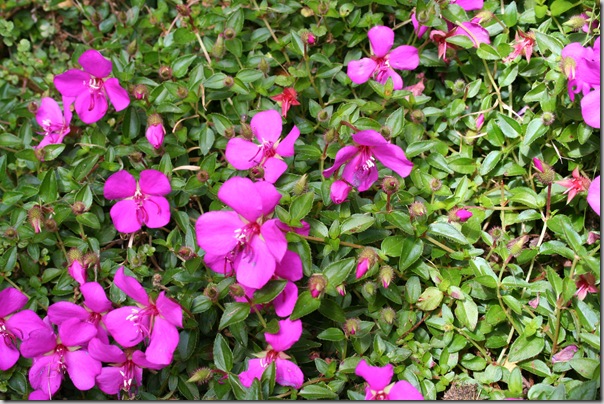
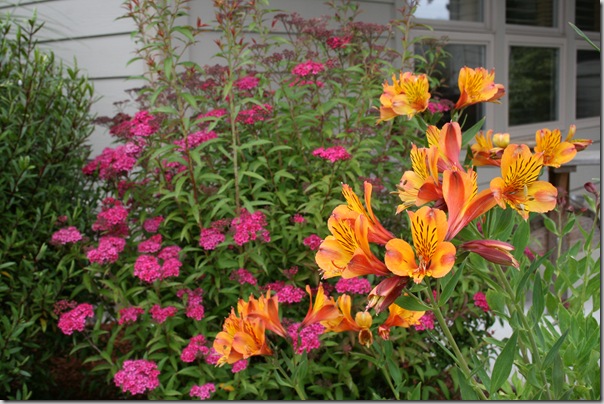
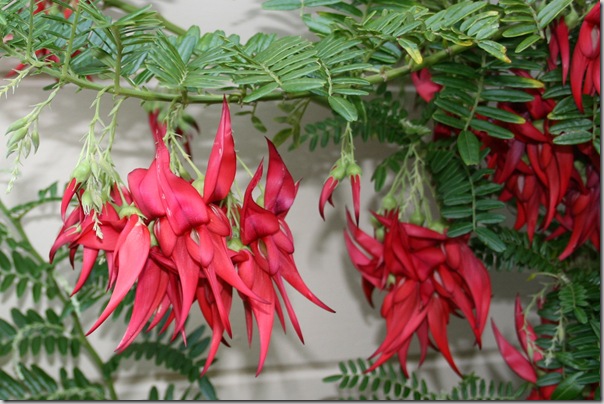
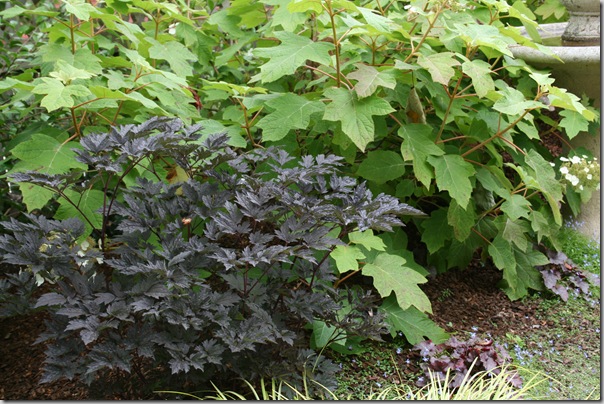
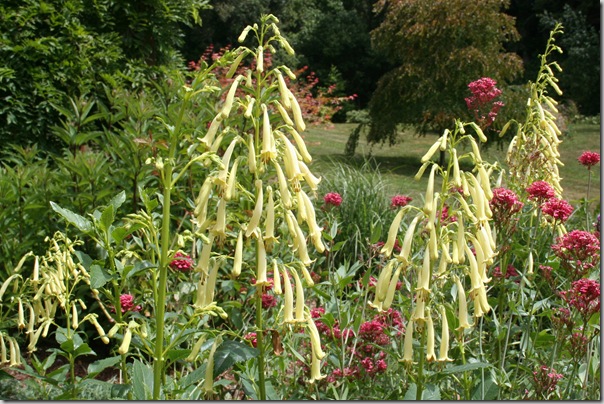
22 responses to “Shamelessly Tropical: Hawt Plants for a Variety of Climates”
[…] : A Garden of Possibilities : Stamford, CT Douglas Owens-Pike : Energyscapes : Minneapolis, MN » Genevieve Schmidt : North Coast Gardening : Arcata, CA » Jocelyn Chilvers : The Art Garden : Denver, CO » Lesley Hegarty & Robert Webber : Hegarty […]
[…] : Stamford, CT Douglas Owens-Pike : Energyscapes : Minneapolis, MN Genevieve Schmidt : North Coast Gardening : Arcata, CA Jocelyn Chilvers : The Art Garden : Denver, CO Lesley Hegarty & Robert Webber : […]
Gen, I LOVE red lobster claws! I don’t think I’ve ever seen those offered as annuals here in CT before. Don’t you just love when common names so perfectly fit a plant? Alstroemeria is a favorite of mine but it does not seem to survive for me, I guess I have a case of zonal denial too.
[…] : A Garden of Possibilities : Stamford, CT Douglas Owens-Pike : Energyscapes : Minneapolis, MN » Genevieve Schmidt : North Coast Gardening : Arcata, CA » Jocelyn Chilvers : The Art Garden : Denver, CO » Lesley Hegarty & Robert Webber : Hegarty […]
[…] : A Garden of Possibilities : Stamford, CT Douglas Owens-Pike : Energyscapes : Minneapolis, MN » Genevieve Schmidt : North Coast Gardening : Arcata, CA » Jocelyn Chilvers : The Art Garden : Denver, CO » Lesley Hegarty & Robert Webber : Hegarty […]
[…] : A Garden of Possibilities : Stamford, CT Douglas Owens-Pike : Energyscapes : Minneapolis, MN » Genevieve Schmidt : North Coast Gardening : Arcata, CA » Jocelyn Chilvers : The Art Garden : Denver, CO » Lesley Hegarty & Robert Webber : Hegarty […]
Isn’t it funny how the grass is ALWAYS greener, zonewise? How about we trade your Zone 9 for my Zone 6 for a while? 😉 I am going to have to check into the fact that there’s a hardier Phygelius, though…
Exotic indeed. The only one I’m familiar with is the Cimicifuga, or Snakeroot. BTW, I’m on this month’s list but it seems I was omitted from the announcement at GDRT.
[…] : Personal Garden Coach : Renton, WA » Douglas Owens-Pike : Energyscapes : Minneapolis, MN » Genevieve Schmidt : North Coast Gardening : Arcata, CA » Jocelyn Chilvers : The Art Garden : Denver, CO » Lesley Hegarty & Robert Webber : Hegarty […]
The Actea simplex (new name for Cimicifuga) is native here and often seen in the woods because it is a tough, deer resistant plant. Try ‘Black Negligee’ too. Your choices are so exotic that they boggle the mind~bravo!
Great post, Gen! I must try that Cimicifuga, it’s a killer! I should try Phygelius again; I’ve never been able to please it enough to spread (lower humidity here maybe?) Thanks for the treats, nicely done!
Because black cohosh (A. racemosa) is a favorite plant of mine, I discovered they (whoever “they” are) changed the genus name Cimicifuga to Actaea a few years ago. I don’t like the spelling and Cimicifuga is so fun to say. Well, no one ever asks me! The A. simplex looks gorgeous!
What a great post.
Lots of old friends here!
Use to grow Clianthus puniceus against a white wall and lit at night – amazing.
Phygelius on the other hand is now a nuisance since it runs and gets eaten too!
Our experiences of plants are all so interestingly different.
Best Wishes
Robert
I must have a red lobster claw!!!!! Beautiful plant pics!
I haven’t seen nor planted Heterocentron elegans since leaving the Pacific coast 24 years ago.
I use to buy it from Gary Rattway of Digging Dog Nursery when he was overseeing the Mendocino Botanical garden and ran a small wholesale nursery out of the back of the grounds.
You’re so lucky to have access to this plant ! It is certainly underutilized in my repertoire due to its unavailability.
Great list of fun plants.
What a joy it is to read all your comments on these plants!
Michelle, I am lucky to have a small wholesale grower who probably got a snipping of this plant from Digging Dog! He’s spoken a number of times of visiting there and being friendly with the owner. The stuff spreads so readily that I’ve actually grown my own for clients when his supply runs short on me. I just pop some into a heaped flat of potting soil and wait a few months.
I couldn’t wait to read your post this month, Gen! What treasures you’ve shared with us – I, too, love the Third Harmonic, but have never even heard of Heteroncentron! Thanks for the tip – I must hunt this one down!
Scrolling down through your post I find myself wanting to stretch the zonal boundaries all the way to our 5b! The Clianthus would be a huge hit here in New England, with its resemblance to our coveted ocean delicacy. Very interesting tip regarding cutting the Alstroemeria. Cimicifuga is one of my favorites, and we use several varieties including brunette but, as you stated, it is not well known here. Thanks for all the great info!
Scott, that cracks me up. Debbie pointed out that same similarity to actual lobsters on Twitter. You New Englanders!
I’d love to read about more varieties of that Cimicifuga/ Actaea – maybe that’s a post idea for you someday! I only have two varieties locally available – both a lovely dark blackish color.
I am laughing so hard. This is an excellent post for me. My client said to me the other day…” I want it to look tropical.” Now I have some ideas. We’ll see how these beauties do in Trinidad. Thanks so much!
Awesome, Jill! Are you in Trinidad here in Humboldt, or another Trinidad? In any case, I hope the plants work for you! 🙂
[…] : A Garden of Possibilities : Stamford, CT Douglas Owens-Pike : Energyscapes : Minneapolis, MN » Genevieve Schmidt : North Coast Gardening : Arcata, CA » Jocelyn Chilvers : The Art Garden : Denver, CO » Lesley Hegarty & Robert Webber : Hegarty […]